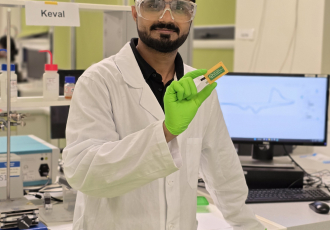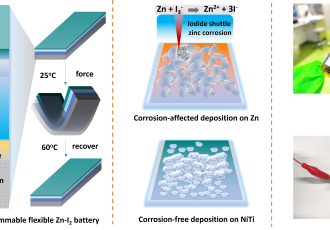25. Sept. 2025
As modern technology increasingly demands batteries that are safer, long-lasting, and more adaptable, researchers at CEITEC BUT have developed a novel solution for energy storage. In a recent breakthrough, Keval K. Sonigara and colleagues from the Future Energy and Innovation research group at CEITEC BUT, led by Martin Pumera, have designed a zinc-iodine battery that not only resists corrosion but can also recover its original shape after being bent. By combining smart materials with clever electrochemical design, this innovation opens new possibilities for flexible electronics, wearable devices, as well as large-scale grid storage.
Most rechargeable batteries today rely on lithium-ion chemistry. While widely used, these batteries pose safety risks such as fire hazards and face challenges due to limited regional resources for production. As a result, there is an urgent need for safer alternatives that can be used reliably in wearable devices as well as robotic systems.
Batteries with a Memory
Keval K. Sonigara and colleagues have demonstrated that integrating smart shape-memory alloys transforms conventional rigid aqueous batteries into highly flexible, long-term stable devices. They have engineered a sustainable zinc-ion battery that uses water-based electrolytes and can be fabricated under standard laboratory conditions. Furthermore, the design employs iodine as a low-cost cathode component with abundant global reserves, offering a safer alternative to conventional lithium-ion systems.
Despite the promising cost and safety advantages of iodine-based cathodes and zinc anodes, practical deployment has been limited by issues such as zinc corrosion through iodine. As a breakthrough, Sonigara introduced Nitinol, a nickel-titanium shape-memory alloy, into the zinc anode compartment. Nitinol not only resists corrosion but also allows the flexible design of the battery with shape memory, which allows the battery to return to its original shape after deformation. These results are detailed in a recent open-access article in Advanced Energy Materials, one of the world’s top energy journals (impact factor: 26.0) Corrosion-Resistant Shape-Programmable Zn–I2 Battery.
Vision for European Energy Self-Reliance
Sonigara also highlighted Europe’s reliance on imported battery materials and the importance of developing local solutions. He pointed out the potential of seawater-derived iodine and home-developed aqueous battery technologies to move Europe toward energy self-sufficiency. With the aqueous battery market projected to exceed $10 billion by 2030, these advances mark a significant step toward a greener and more sustainable energy future.
Battery Performance and Future Directions
The newly developed battery delivers a stable output of 1.25 volts per cell with energy densities exceeding 100 Wh/kg. Thanks to the Nitinol-supported zinc anode, it demonstrates exceptional durability, performing reliably over more than 10,000 cycles in laboratory tests. Its design is suitable for both scaling up to grid-level energy storage and integration into consumer and wearable devices.
Looking ahead, the CEITEC team is continuing to explore advanced chemistries and solid-state designs to further advance aqueous battery technology and better meet current market demands.


 Share
Share



